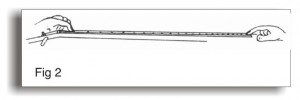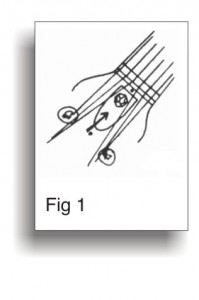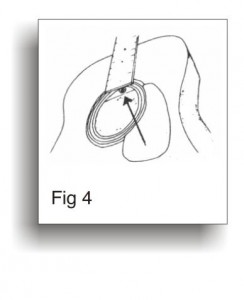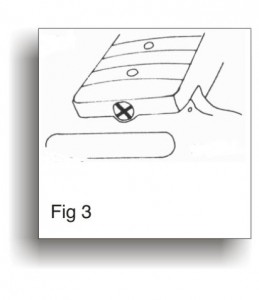FUNCTION OF THE TRUSSROD: To straighten the neck.
INDICATION OF PROBLEMS WITH THE TRUSSROD: Bowed neck away from strings causing high action. (or the opposite) Bowing into the strings causing fret buzzing and/or too low action.
WHAT TO LOOK FOR: Here is how to determine if the rod needs adjusting: With the strings tuned to standard pitch, hold the low E string down at both the 1st fret and at the last fret on the fingerboard. (See Fig. #2) By doing this, you have made this string a straight edge (a perfectly straight line). With this straight line now sitting right over the fingerboard, sight (look) along the string at each fret and notice how close each fret wire is to the string. If each successive fret wire goes away from the string (as you look to the middle) then the neck is bowing away from the strings.

This is the most common bow which will make the strings be high off the fingerboard and hard to play.
If you sight along the string and you see the string touching the top of each fret wire, then you have a back bow. Here, the neck is actually bowing towards the strings. When this happens, you will get a lot of fret buzzing or even dead notes that won’t play.
Ideally, you should have just a slight bow away from the strings. I like to make the neck straight and then turn the rod back to allow for this slight bow. This lessens the chance of fret buzz while making the neck very playable.
ADJUSTMENTS: To adjust the rod, always approach the adjustment nut straight on, to determine which way to turn the adjuster, clockwise or counter clockwise. (See Fig. #1) Always do this adjustment with the strings on and tuned to pitch.

SO… if the neck bows away from the strings as you face the rod, turn it CLOCKWISE to tighten the nut. This will straighten the bow.
OR… if your neck bows into the strings (back bow), then you will turn the adjusting nut COUNTER- CLOCKWISE.
Note: if you have loosened the truss rod nut all the way and you still have back bow, you will need to take the instrument to a professional repair- person. This problem must be dealt with in a manner beyond the scope of this guide.
Because we need to make these adjustments with the strings on and tuned to pitch, we want to take a moment here to talk about how to work around the strings. If the adjuster is at the head stock, set the two middle strings off to the slots next to them. This will leave them about at pitch, but out of your way for working. If your adjustment is made through the sound hole, (See Fig. #4) you can do this adjustment without having to loosen the strings.

Wrap the barrel of the adjusting tool with many layers of masking tape so you won’t be pushing the metal tool against the metal strings, which will damage the strings. Then pull the strings out of the way with one hand, while making the adjustment with the other.
In some cases you will have to completely loosen the strings to make the adjustment. For example some bolt on neck electrics (Fig# 3) or with instruments where the adjuster doesn’t seem to want to turn very easily.

With these, you often have to loosen the strings to loosen the tension on the neck before it will turn properly. If this is the case, before loosening the strings, look at the amount of bow in the neck. Loosen the strings, turn the adjuster one quarter to one half a turn, tune the instrument back to pitch, and again sight along the neck to see how much the bow was affected. Repeat the procedure until you are happy with the results. Be patient!
Very often the Truss Rod adjustment is the only adjustment needed to make the instrument play well.
CAUTIONS: DO NOT tighten the rod too tight. If it feels like it doesn’t want to turn, don’t force it, you could break the rod or strip the threads of the adjuster. If this is the case, take the instrument to a reputable repairperson.
REMEMBER, turning the rod is not for lowering or raising the action! It is for straightening the neck.
There is a common misconception that after turning the truss rod, you need to wait a period of time for it to “set up”. This is wrong. If your truss rod is working properly, you will see the results immediately.
